Past Exhibitions
Boston Views: Through the Lens of Arthur A. Shurcliff
6 May 2024 to 28 February 2025
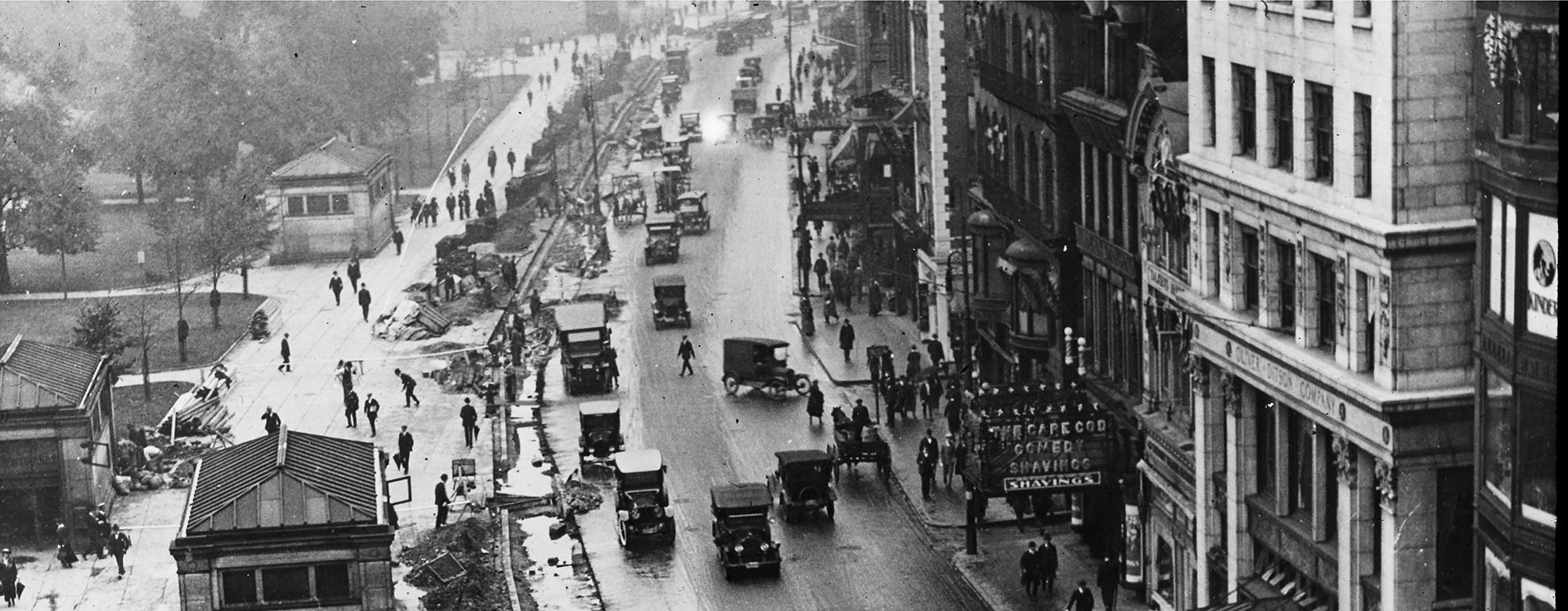
Views of Boston captured on glass.
Arthur Asahel Shurcliff (1870–1957), a landscape architect, created a collection of 1,295 glass lantern slides that depict cityscapes and buildings in Boston during the first decades of the 20th century, and much more. In addition to the views of Boston reproduced here, there are slides of historical maps and paintings, plans and drawings created by Shurcliff to illustrate urban growth and land use, and early aerial photographs of Boston and other cities. Both the content and arrangement of the collection suggest that Shurcliff used the lantern slides to illustrate presentations to state and city planning boards, as well as lectures before educational and civic organizations.
Although Shurcliff discussed visiting sites to take photographs and creating lantern slides in his diaries, it is not possible to identify specific slides as his personal work, rather than photographs taken by others or commercially reproduced.
"The Dye is cast": Interests & Ideals That Motivated the Boston Tea Party
5 October 2023, to 29 February, 2024
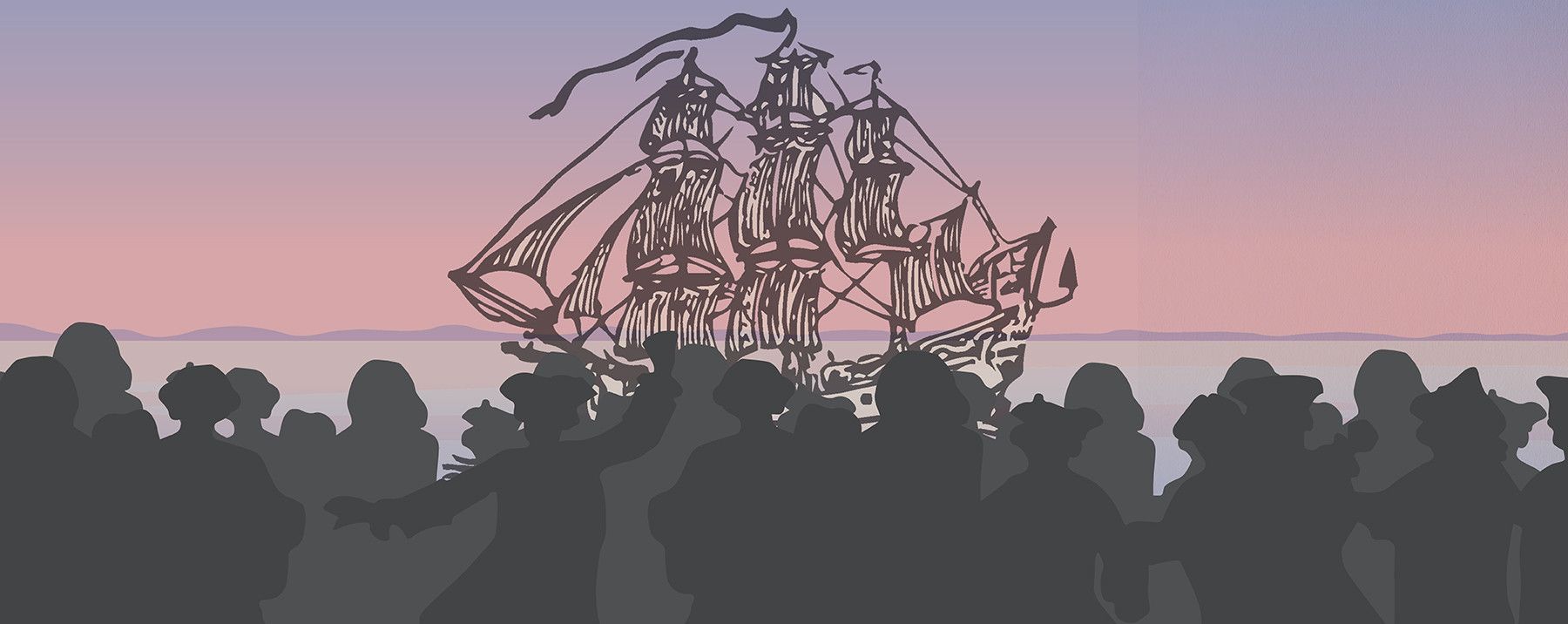
Commemorate the 250th anniversary of the Boston Tea Party.
In 1773, Boston was on the verge of revolution. Bostonians were not united in their opinions about, or even their interest in, what took place on the evening of 16 December. This exhibition delves into this pivotal moment in American history through the perspectives of six individuals from diverse backgrounds and features a remarkable collection of artifacts and documents from the MHS collection.
Featured individuals include Paul Revere, Joseph Warren, Phillis Wheatley, Prince Hall, John Rowe, and Thomas Hutchinson, whose stories give insight as to why the Boston Tea Party happened. The exhibition will showcase historical artifacts, including the Tradesmen's Protest against the Proceedings of the Merchants, November 3, 1773, and the Edes family punch bowl, as well as immediate reactions to the event, among others. These items provide tangible connections to the past and allow visitors to immerse themselves in the historical context of the Boston Tea Party.
MassArt at 150: Tradition and Innovation
1 May to 15 September 2023

Celebrate the 150th anniversary of the first independent publicly-funded art and design college in the United States.
Did you know that Massachusetts was the first state to mandate art education in public schools? The Massachusetts Normal Art School opened its doors in 1873 to train art teachers in response. Today, Massachusetts College of Art and Design, as it is now called, continues to train teachers, but it also develops the creative workforce in a wide range of areas including fine arts, industrial design, architecture, communications, film/video, animation, illustration and more.
MassArt at 150 celebrates the sesquicentennial of the only publicly funded art and design college in the United States. This two-part exhibition honors the ten-year partnership between MassArt’s Illustration Department and the Handel + Haydn Society and recognizes 150 years of design by MassArt alumni. Visitors can view a retrospective of student and alumni work created in response to a masterwork performed by Handel + Haydn and explore a selection of clothing, equipment, advertising, everyday household items, and innovations designed by MassArt alumni curated by MassArt’s Archives Department.
Our Favorite Things: Objects that Fascinate, Interest & Inspire
Part 3
10 October 2022 to 25 February 2023
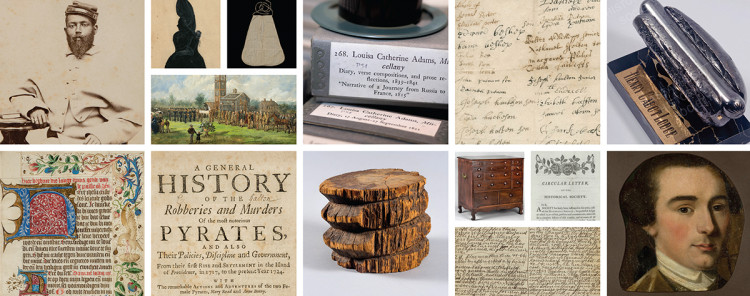
View items chosen by MHS staff that speak to real people, real stories, and real history from the MHS collection.
When founder Jeremy Belknap set out to build the collection of the MHS in 1791, he envisioned a Society not only of “books, pamphlets, manuscripts, maps or plans,” but also material items that could help Americans understand their history. Part three of this year-long exhibition explores an eclectic cross section of the visual and material culture found in the MHS collection. Visitors can learn about a 1692 petition to spare a woman’s life and the portrait of a soldier whose image was preserved but not his name as well as a bronze hot dog presented as a campaign gift in the 20th century and a wooden screw used to make a mammoth cheese in the 18th century. Explore the online exhibition.
Our Favorite Things: Objects that Fascinate, Interest & Inspire
Part 2
15 May 2022 to 30 September 2022
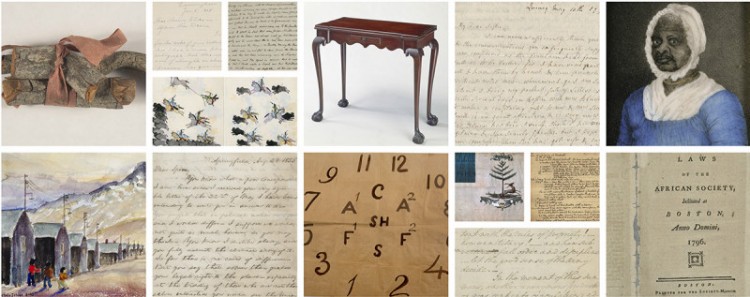
View items chosen by MHS staff that speak to real people, real stories, and real history from the MHS collection.
Part two of this year-long exhibition explored the call of liberty and the complex nature of American freedom and unfreedom. Visitors read how Abraham Lincoln grappled with the horrors of slavery, witnessed an especially dark moment from World War II through 1943 paintings of a Japanese-American internment camp in Wyoming, and were inspired by a portrait of Elizabeth Freeman, an enslaved person who successfully sued for her freedom. Phillis Wheatley’s desk was on display for visitors to imagine her writing her way into the American literary canon. They were able to picture Mary Smith Cranch pulling letters from her pocket or the members of the African Society drafting laws of governance, both declaring that they, too, claim a place in the American republic. Explore the online exhibition.
Our Favorite Things: Objects that Fascinate, Interest & Inspire
Part 1
6 December 2021 to 30 April 2022
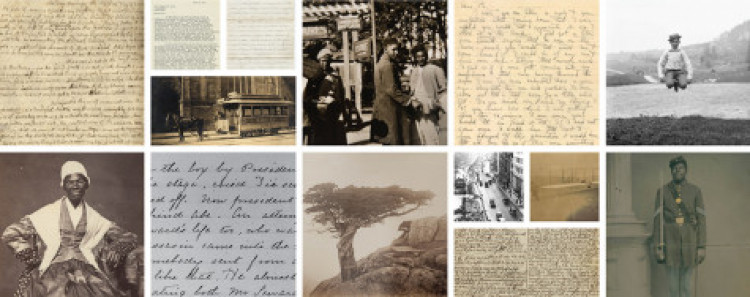
View items chosen by MHS staff that speak to real people, real stories, and real history from the MHS collection.
With millions of letters, diaries, photographs, and objects in our holdings, the stories we can tell at the MHS are countless. Our Favorite Things connects a selection of compelling, captivating, and amusing items from our collection to the backgrounds, interests, and memories of the MHS staff. Part one of this year-long exhibition displayed a selection of works by professional and amateur photographers who documented 19th– and early 20th–century American history as it unfolded. Also on display were artifacts and accounts of the human experience of war including letters and diary entries from the battlefields of the Revolutionary War, Civil War, and World War I, and photographs of intrepid African Americans who served in the Civil War. Explore the online exhibition.
Fire! Voices from the Boston Massacre
31 October 2019 to 31 May 2020

Witnessed and described by many, in both words and images, the Boston Massacre may be one of the least understood incidents in American history. Though contradictory accounts and testimony led to acquittals for all of two of the accused soldiers, the “massacre” became a landmark event on the path to revolution.
On the evening of March 5, 1770, soldiers occupying the town of Boston shot into a crowd, killing or fatally wounding five civilians. In the aftermath of what soon became known as the Boston Massacre, questions about the command to “Fire!” became crucial. Who yelled it? When and why? Because the answers would determine the guilt or innocence of the soldiers, defense counsel John Adams insisted that “Facts are stubborn things.” But what are the facts? The evidence, often contradictory, drew upon testimony from dozens of witnesses. Through a selection of artifacts, eyewitness accounts, and trial testimony—the voices of ordinary men and women—Fire! Voice from the Boston Massacre explores how this flashpoint changed American history.
Learn more at Commemorating the 250th Anniversary of the Boston Massacre and Perspectives on the Boston Massacre.
"Can She Do It?" Massachusetts Debates a Woman’s Right to Vote
26 April to 21 September 2019

Colorful political cartoons, engaging campaign materials, and visual propaganda illustrate the passion of those who argued for and against women’s suffrage.
Commemorating 100 years since Massachusetts ratified the 19th Amendment, this exhibition explores the activism and debate around women’s suffrage in Massachusetts. Featuring dynamic imagery from the collection of the MHS, “Can She Do It?” Massachusetts Debates a Woman’s Right to Vote illustrates the passion on each side of the suffrage question.
Fashioning the New England Family
5 October 2018 to 6 April 2019

A journey through several centuries of New England style in an exhibition of clothing, fabric, accoutrements, and associated manuscripts.
Fashioning the New England Family explored the ways in which the multiple meanings of fashion and fashionable goods are reflected in patterns of consumption and refashioning, recycling, and retaining favorite family pieces. Many of the items featured had been out of sight, having never been exhibited for the public or seen in living memory. The exhibition enabled scholars, students, and professionals in fields such as fashion, material culture, and history the chance to see these items for the first time. It encouraged research and provided the possibility for new discoveries. The public were able to view in detail painstaking craftsmanship, discover how examples of material culture relate to significant moments in our history, and learn how garments were used as political statements, projecting an individual’s religion, loyalties, and social status.
The exhibition was organized as part of MASS Fashion, a consortium of eight cultural institutions set up to explore and celebrate the many facets of the culture of fashion in Massachusetts.
Entrepreneurship & Classical Design in Boston’s South End: The Furniture of Isaac Vose & Thomas Seymour, 1815 to 1825
11 May to 14 September 2018

Virtually forgotten for two-hundred years, the brilliance of Isaac Vose and his furniture were revealed in an exhibition and accompanying volume.
Beginning with a modest pair of collection boxes he made for his local Boston church in 1788, Isaac Vose went on to build a substantial business empire and to make furniture for the most prominent Boston families until his shop closed in 1825. Entrepreneurship & Classical Design in Boston's South End showcased a number of pieces by the workshop of Isaac Vose through the vision of guest curators and authors Robert Mussey and Clark Pearce. The exhibition and accompanying book help to restore Vose from relative obscurity to his rightful position as one of Boston’s most important craftsmen.
The complementary book, Rather Elegant Than Showy (May 2018), by Robert Mussey and Clark Pearce, is available for sale at the MHS.
Image: Couch, Isaac Vose & Son, with Thomas Wightman, carver, Boston, 1824. Historic New England, Gift of the Massachusetts Historical Society (1923.507); photograph by David Bohl.
Yankees in the West
6 October 2017 to 6 April 2018

Yankees in the West explored how a generation of eastern tourists set out to claim their story line in the expanding narrative of the American West.
The American West has long loomed large in the popular imagination. Depicted alternately as a harsh, untamed, and unpopulated wilderness; a land of opportunity; and the embodiment of America’s sense of entitlement through manifest destiny, realizing western promise was a dominant theme throughout the 19th century. Beginning mid-century, descriptions of the trans-Mississippi West flowed steadily east, capturing the Yankee eye and fueling still steadier streams of westward travel. Through a selection of letters, diaries, artifacts, photographs, and drawings, Yankees in the Westexplored how New Englanders experienced the trans-Mississippi west in the late 19th and early 20th centuries.
The Irish Atlantic: A Story of Famine, Migration, & Opportunity
10 March to 22 September 2017

This exhibition explored the impact of generations of Irish in Boston from famine relief efforts to a mass migration movement, community and institutional building, and a rise in political power.
The Irish have long had an important presence in Boston. The Irish Atlantic: A Story of Famine, Migration, & Opportunity, co-sponsored by the Massachusetts Historical Society and the Forbes House Museum, explored the Irish in Boston from famine relief efforts to a mass migration movement, decades of community and institutional building, and a rise in political power.
Watch this video for an overview of the exhibit by guest curator William M. Fowler, Distinguished Professor of History at Northeastern University.
See the exhibit’s companion website for an overview, timeline, and interviews with Mayor Martin Walsh; Consul General of Ireland Fionnuala Quinlan; former mayor and ambassador Ray Flynn; guest curator and Northeastern University professor William Fowler, Jr.; Stephen T. Riley Librarian at the MHS Peter Drummey; attorney and author Christian Samito; Boston College professor James O'Toole; and guest historian Catherine Shannon.
Turning Points in American History
10 JUNE 2016 TO 25 FEBRUARY 2017

Turning points as described in eyewitness accounts, personal records, and artifacts in the Society's collections were explored in the exhibition.
Turning Points in American History examined 15 decisive moments when everything suddenly changed or a process began that would change what followed. These are not the only, or even the most important, events in American history, but turning points described in eyewitness accounts and personal records, or commemorated by "dumb witnesses"--artifacts found in the Society's enormous collections. The exhibition included an account of sailing a small boat through New York Harbor on 11 September 2001; the opening of the American West in the 19th century; the abolitionist movement and the Civil War; the American Revolution and the birth of the United States; and John Winthrop's account of setting sail for New England in 1630.
The Private Jefferson: From the Collections of the Massachusetts Historical Society
29 JANUARY TO 26 MAY 2016

Through the Society’s collections, the exhibition uncovered one of the most famous yet enigmatic and private Americans, Thomas Jefferson.
Thomas Jefferson has been described as an “American Sphinx.” As the drafter of the Declaration of Independence and the third President of the United States, he is one of the most famous Americans. Nevertheless, he is an enigmatic figure. Through a selection of architectural drawings, writings and correspondence, and record books from the collections of the MHS, this exhibition pulled back the veil and uncovered the private Jefferson.
One of the Society’s greatest treasures is the Coolidge Collection of Thomas Jefferson Manuscripts. The collection is comprised of letters, journals, record books, accounts, and more than 400 architectural drawings—almost 9,500 documents in all—collected by Jefferson’s descendants who lived in Massachusetts and donated them to the Society.
Thomas Jefferson Papers: An Electronic Archive presents digital images and searchable transcriptions of a selection of Jefferson's personal papers, including his Farm and Garden Books, the manuscript of Notes on the State of Virginia, his only full-length published work, and his handwritten copy of the Declaration of Independence. The website also features digital images of Jefferson's architectural drawings and sketches of two of his library catalogs.
The Private Jefferson: Perspectives from the Collections of the Massachusetts Historical Society, a full-color, extensively illustrated publication with essays by Henry Adams, Peter S. Onuf, and Andrea Wulf, and published by the MHS is available for purchase online or at the Society.
Terra Firma: The Beginnings of the MHS Map Collection
2 OCTOBER 2015 TO 9 JANUARY 2016

The MHS map collection—one of the Society’s most diverse and interesting— includes landmarks of map publishing.
Terra Firma celebrated the beginnings of one of the Society's most diverse and interesting collections. Among the maps in the exhibition were landmarks of map publishing that included the first published map of New England, the first map of Massachusetts published in America, and a unique copy of the earliest separate map of Vermont, as well as maps of important battles and maps and atlases from the United States and beyond.
Learn more about four of the mapmakers at www.masshist.org/terrafirma.
God Save the People! From the Stamp Act to Bunker Hill
27 FEBRUARY TO 4 SEPTEMBER 2015

Immerse yourself in the tumultuous times leading to revolution with an exhibition of letters, diaries, political cartoons, newspapers, maps, artifacts, and portraits.
“The decisive Day is come on which the fate of America depends,” writes Abigail Adams to John Adams after the Battle of Bunker Hill in a letter dated June 18-20, 1775. Two hundred and fifty years after the enactment of the Stamp Act in 1765, the Society is commemorated this decisive era with an exhibition to tell the story of the coming of the American Revolution in Boston. God Save the People! From the Stamp Act to Bunker Hill followed the evolution of colonial thought and political action through the letters and diaries of men and women caught up in the conflict, together with political cartoons, newspapers, maps, artifacts, and portraits.
Explore the coming of the American Revolution through the following online displays.
Perspectives of the Boston Massacre is an interactive website that allows visitors to examine materials offering a range of perspectives related to the events of 5 March 1765.
The Siege of Boston presents more than one dozen accounts written by individuals personally engaged in or affected by the siege, which occurred from April 1775 to March 1776.
The Annotated Newspapers of Harbottle Dorr, Jr., presents the complete four-volume set of Revolutionary-era Boston newspapers and pamphlets assembled, annotated, and indexed by Harbottle Dorr, Jr., a shopkeeper in Boston.
Discover the fears, friction, and turmoil that shaped these times with The Coming of the American Revolution, a web display of newspapers, official documents, and personal correspondence arranged into fifteen key topics.
Letters & Photographs from the Battle Country: Massachusetts Women in the First World War
12 JUNE 2014 TO 24 JANUARY 2015

An exhibition of letters, photographs, and other memorabilia assembled to commemorate the centenary of the first World War.
To commemorate the centennial of the outbreak of World War I, the MHS organized the exhibition Letters and Photographs from the Battle Country: Massachusetts Women in the First World War, focusing on two of the hundreds of women from the Commonwealth who went to France as members of the U.S. armed forces, the Red Cross, and other war relief organizations. From the Society’s extraordinary collection of women’s remembrances, the exhibition featured photographs, letters, diaries, and memorabilia related to Margaret Hall and Eleanor (Nora) Saltonstall, Red Cross volunteers in France. Both women were keen observers of the climactic months of the war and depicted what they witnessed in vivid detail.
Purchase the MHS publication Letters & Photographs from the Battle Country: The World War I Memoir of Margaret Hall.
View all of the photographs from Margaret Hall's memoir on our companion website.
Tell It with Pride: The 54th Massachusetts Regiment & Augustus Saint-Gaudens' Shaw Memorial
21 FEBRUARY TO 23 MAY 2014

The exhibition was organized by the National Gallery of Art, Washington
In commemoration of the Civil War battle of Fort Wagner led by Colonel Robert Gould Shaw and the men of the 54th Massachusetts Regiment and in cooperation with the Massachusetts Historical Society, the National Gallery of Art in Washington, D.C. organized the exhibition Tell It with Pride: The 54th Massachusetts Regiment & Augustus Saint-Gaudens’ Shaw Memorial.
The exhibition celebrated Augustus Saint-Gaudens’ magisterial Shaw Memorial (1883–1900).The monument commemorates the July 18, 1863 storming of Fort Wagner, near Charleston, South Carolina. The Civil War battle was waged by Colonel Robert Gould Shaw and the 54th Massachusetts Regiment, one of the first African American military units raised in the North. Although the 54th was defeated at Fort Wagner and almost a third of the regiment was killed—including Shaw himself—or wounded, the battle was seen as a turning point in the war: it proved that African Americans’ bravery and dedication to country equaled that of the nation’s most celebrated heroes.
Learn more about items in the Society's collection related to the 54th Massachusetts Regiment.
Read about the sword Robert Gould Shaw carried at the assault on Fort Wagner.
The Cabinetmaker & the Carver: Boston Furniture from Private Collections
4 OCTOBER 2013 TO 17 JANUARY 2014

An extraordinary opportunity to view nearly 50 examples of rarely seen furniture borrowed from private collections in the greater Boston area.
Boston has been the home of an important furniture trade since the mid- 17th century. As part of the Four Centuries of Massachusetts Furniture collaboration, the Massachusetts Historical Society presented an exhibition covering several centuries of a rich and varied furniture-making tradition. Visitors were able to explore nearly 50 examples of rarely seen furniture borrowed from distinguished private collections in the greater Boston area. Ranging in date from the late-17th century to about 1900, these privately held treasures, generously lent by their owners, provided a look at the trajectory of cabinetmaking in the Hub. Supplemented with complementary materials from the Society’s collections the exhibition explores furniture as history and provides a look at Boston’s distinctive urban tradition.
A full-color, extensively illustrated catalogue written by guest curator Gerald W. R. Ward and published by the MHS is available for purchase online or at the Society. Learn more about The Cabinetmaker & the Carver: Boston Furniture from Private Collections.
The Object of History: 18th-Century Treasures from the Massachusetts Historical Society
13 JUNE TO 7 SEPTEMBER 2013

Explore how documents and artifacts can tell us about the characters, events, and issues of the past.
What is the meaning of historical objects? Why are they preserved, and why have they survived? Are they valued for their associations with notable historical figures or landmark events, as objects of beauty, as the survival of relics from a distant past, or for the stories they convey? The exhibition explores these questions through the display of 18th-century portraits and objects from the Society's collections, along with rarely seen engravings, needlework, maps, weapons, furniture, clothing, scientific instruments, and silver.
"Proclaim Liberty Throughout All the Land": Boston Abolitionists, 1831-1865
22 FEBRUARY TO 24 MAY 2013

Manuscripts, broadsides, artifacts, and portraits from the Society’s collections illustrate the role of Massachusetts in the national debate over slavery
In the decades leading up to the Civil War, Boston became a center of the national antislavery movement, and in 1831 William Lloyd Garrison, "all on fire" for the cause, began publication of The Liberator, the country's leading abolitionist newspaper. There was strong resistance to the radical movement not only in the slave-holding South, but among Northerners as well. "Proclaim Liberty Throughout All the Land": Boston Abolitionists, 1831-1865, featured manuscripts, broadsides, artifacts—including the imposing stone for The Liberator—and portraits of key players to illustrate the role of Massachusetts in the national debate over slavery, and to demonstrate how the movement was communicated and followed.
In Death Lamented: The Tradition of Anglo-American Mourning Jewelry
28 SEPTEMBER 2012 TO 31 JANUARY 2013

The exhibition featured exemplary types of mourning jewelry from early gold bands with death’s head iconography to jeweled brooches and intricately woven hairwork pieces
Mourning jewels, tangible expressions of love and sorrow, were the focus of In Death Lamented: The Tradition of Anglo-American Mourning Jewelry. More than 80 objects representing some of the best examples of this type of jewelry were featured. The exhibition explored our culture’s shifting attitudes towards death, grief, and mourning as reflected in the materials, imagery, and stylistic forms of mourning jewelry, portraits, broadsides, and letters. Drawn from the Society’s and Guest Curator Sarah Nehama’s collections as well as select loans, exhibition highlights include the Society’s Adams-Winthrop commemorative seal ring containing the braided hair of John Quincy Adams and a gold memorial ring for Caroline of Brandenburg-Ansbach, the queen consort to George II of Great Britain, from the collections of Sarah Nehama.
A Gilded and Heartbreaking Life: The Photographs of Clover Adams
9 FEBRUARY TO 9 JUNE 2012

The exhibition showcased Clover Adams's striking photographs, many of which had not been seen before publicly.
In May 1883, Clover Adams, a descendant of Boston’s Sturgis and Hooper families and the wife of the historian Henry Adams, picked up her camera and began taking photographs—of her husband, of afternoons at the beach on Boston’s North Shore, and of eminent friends who frequented the Adamses’ home on Lafayette Square in Washington, D.C., including Oliver Wendell Holmes, Jr., H. H. Richardson, Francis Parkman, George Bancroft and John Hay. Based on Natalie Dykstra’s book, Clover Adams: A Gilded and Heartbreaking Life, published by Houghton Mifflin Harcourt in February 2012, the exhibition showcased Clover’s striking photographs, many of which had not been seen before publicly. It also highlighted Clover’s many letters, the notebook she used to record the chronology and technical aspects of her photographs, as well as Henry’s letters, and other family materials.
See the exhibition's companion website.
The Purchase by Blood: Massachusetts in the Civil War, 1861-1862
7 OCTOBER 2011 TO 13 JANUARY 2012

With letters, photographs, broadsides, journals, and art, the exhibition followed a small group of officers—husbands, brothers, and friends of the first families of Massachusetts—through the first years of the Civil War.
Following the surrender of Fort Sumter on April 13, 1861, Northerners rallied behind President Lincoln’s call for states to send troops to preserve the Union. The Purchase by Blood: Massachusetts in the Civil War, 1861-1862 followed a small group of officers—husbands, brothers, and friends of the first families of Massachusetts—through the first years of the Civil War. These young men, like so many, wanted to feel the glory of combat and enlisted with a sense of adventure and unquestioning patriotism. Not anticipated was the bloody aftermath of early conflicts—the Battle of Ball’s Bluff, the Seven Days Battle, the Battle of Cedar Mountain, the Battle of Antietam—and the horrifying loss of life and optimism. This exhibition showcased letters, photographs, broadsides, journals, and art work surrounding one group of men as the price of war is brought home to Massachusetts.
History Drawn with Light: Early Photographs from the Collections of the Massachusetts Historical Society
11 MARCH TO 17 SEPTEMBER 2011

70-plus photographs arranged in four sections reflected significant historical turning points in the technology and subject matter as photography developed from 1840 to the end of the 19th century.
In 1840, almost as soon as photography arrived in America, the MHS began to collect images of notable figures, artifacts, and landscapes recorded with "the pencil of nature." Examples of these early photographs were displayed in History Drawn with Light: Early Photographs from the Collections of the Massachusetts Historical Society. Visitors were able to see one of Boston's oldest photographs, taken of the Old Feather Store by MHS Member Francis C. Gray, together with portraits and views by early daguerreotype artists such as Albert S. Southworth and Josiah J. Hawes, and the later work of professional and amateur photographers who documented 19th-century American history as it unfolded.
